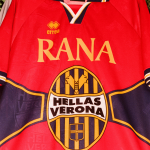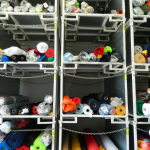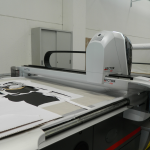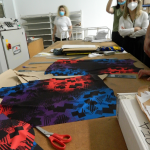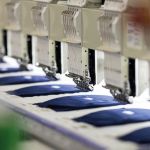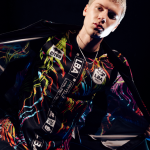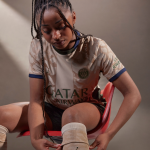
The sporty tailoring of Erreà jerseys
We were guests in the Parma factory to find out how a football jersey is made
May 21st, 2022
The football shirt is more than the sum of its parts. Of course, there is the fabric, technical and futuristic, there is the design, which dances between innovation and tradition, there are the logos, badges and numbers, which link this piece of fabric to so many similar ones that have come before it. But above all, there are the people, the ones who every day choose the design to be made, turn on the sewing machines, cut the patterns, fix the sleeves and collars and hot stamp the letters on the back.
To discover all the secrets behind the creation of a jersey, we went to the Erreà factory in San Polo di Torrile, on the outskirts of Parma, where since 1988 the entire production chain has been followed from conception to creation of a sports uniform. Here, jerseys are still a product of craftsmanship, where the hands that make the game uniforms for thousands of athletes in every nation and discipline have a name and a face. A daily process, well-oiled and error-free, that has allowed the Emilian company to create its own space in a panorama dominated by multinationals in the sector. Compared to its competitors, Erreà is different, following each customer with the same care and professionalism, no matter if it is a promotion team or one of the major European leagues. It is no coincidence that it has just announced its agreement with Middlesbrough, a welcome return given that it had already been the Boro's technical sponsor for fifteen years. Confirmation of how in the long run planning and seriousness works, according to a business model hinged on long-lasting commercial relationships.
We start our visit from the designers' office, led by Alberto Mariani, a former digital kit-creator who has now passed on, where we are shown the knitwear that we will follow step by step until it is made. An integrated supply chain that only exists in very few factories in the world, and which at Erreà is used to perfect the models before starting large-scale production. We then go down through warehouses, where the products are stored before being distributed to retailers, and then arrive in front of the blade machine that transforms the digital pattern into a paper pattern ready to be used in the printing of the various pieces that will make up our knitwear. A sheet is then printed presenting all the elements of the knitwear, each one distinct and already defined by the colour chosen and which, as if by magic, will be transferred onto the fabric thanks to the heat and weight of a giant press. "A one-of-a-kind example, we have three of the five present in Europe," says Roberto Gandolfi, the vice president and son of the founder of Erreà, as well as the Erre of the brand.
A family tradition that perfectly defines the atmosphere we breathe on our rounds, when what is slowly becoming our first knitwear is sewn using at least four different sewing machines to produce the different stitches required by the designer. This is millimetric precision work, carried out with the utmost care using the best equipment available on the market. The array of sewing machines in the factory are all Japanese or German, the result of an investment in quality that the Gandolfi family has not been afraid to make even in a climate that is certainly not favourable to Italian companies. And while everyone is competing to relocate as far away as possible, Erreà continues to manufacture every one of its pieces in Europe, in San Polo di Torrile or in Romania, where it has built a company that follows every aspect in a big way.
The shirt now passes under another press that applies the logos chosen for the occasion, including the first one designed by the founder but never actually used. In its place was chosen that of the double rhombus that ideally encloses the two initials that make up the company's name, including the accent that still catches many people off guard today. Erreà is proud of its identity, which can be recognised in a horizontal organisation devoted to customer satisfaction and sustainability. One of the reasons for pride lies, for example, in the very low rate of returns, less than 1%, which as we know drastically reduces the environmental impact of road transport. This has been achieved by working constantly in contact with the customer, practically only making custom-made products, working alongside a team and listening to their every request in real time.
In the San Polo di Torrile factory, prototypes are thus created, exactly like the one made for us today, which will then be put into production for the customer. In what is defined as a 'sports tailor's shop', the garments are inspected one by one to ensure that they comply with the company's standards and Oeko-Tex Standard 100 certification. In 2007 Erreà was the first company in the teamwear sector in Europe to have obtained such recognition for the quality and sustainability of their products, an achievement of which they are extremely proud and which they told us about during the creation of the jersey. Now that we have the brand new one in our hands and appreciate the attention to detail, we can dive into the historical archive of the jerseys made in over thirty years of activity of the Emilian company.
Obviously those of Parma, of which it has been a sponsor since 2005, being also a small shareholder, but also those of Genoa, the first Serie A team to wear the logo with the two rhombuses on its chest. And then Empoli's shirt with Di Natale's laces, Bari's shirt from the early 1910s, Atalanta's two returns to Serie A and Corini and Verona. But not only Italy, indeed Erreà has been able to expand well beyond national borders and now 60% of its revenue comes from international markets. A glocal approach that has allowed Erreà to dress English, Scottish, Dutch, Swiss, Spanish, Portuguese, and Argentine teams, and then push first towards the Middle East and then Asia. Not to mention the national teams served, some of them - as in the case of Iceland - accompanied from the role of Cinderellas to world prominence.
A gigantic spider's web that covers the entire globe and has its centre here, in San Polo di Torrile, where everything is already ready for the company's next chapter, that of the UEFA Kit Assistance Scheme. The project through which Erreà will produce the official jerseys of eight national teams of small and medium-sized federations - Andorra, Belarus, Cyprus, Faroe Islands Luxembourg, Liechtenstein, Malta and San Marino - from 2022 to 2026. A task that the company took on with its usual seriousness, not limiting itself to creating basic kits for the various teams but designing a template that was then customised according to the requests of each of the teams involved. Even for the football federations at the bottom of the FIFA ranking, a very high level of customisation was designed, which does not stop at just the playing jersey but includes every element of the lifestyle collection.
They tell us that when the delegates from the various federations were invited into the same room where we are now, to see the collections live for the first time, they were almost moved by the work done for them. It is not a difficult scene to imagine; even those of us who have only spent a few hours in their company have been able to feel the professionalism, the dedication but above all the love that this extended family has been putting into making football shirts for thirty years now. And, as we bid farewell to them after a long day, we realised that the uniforms represent not only the identity of those who wear them but also of those who create them.












